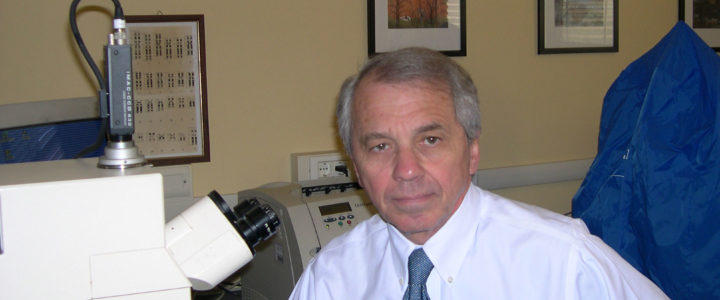With $45,000 in grants from FRAXA Research Foundation over several years, Dr. Miklos Toth of Cornell University studied epigenetics (ie factors other than the gene itself) which can determine symptom severity in Fragile X.
Read moreAuthor: FRAXA Research Foundation
Mouse Models of Fragile X Syndrome

Dr. Ben Oostra and his team at Erasmus University completed and published multiple studies related to Fragile X syndrome. They created the first Fragile X knockout mouse model and went on to perform many critical studies in Fragile X mouse models.
Read moreRole of Matrix Metalloproteinases (MMP-9) in Fragile X

With a $220,000 grant from FRAXA Research Foundation over 3 years, Dr. Iryna Ethell from the University of California at Riverside studied the regulation of dendritic structure by matrix metalloproteinases and other extracellular signaling pathways. This work identified a major treatment strategy for Fragile X with the available MMP-9 inhibitor, minocycline.
Read moreNovel Functions of Drosophila FMRP

With a $120,000 grant from FRAXA Research Foundation over 2 years, Dr. Thomas Dockendorff from the University of Tennessee and his colleagues were pioneers in using the power of fly genetics to understand the different functions of the fly version of the Fragile X protein.
Read moreBasic Mechanisms of Disease and Potential Therapeutic Strategies

With $245,000 in grants from FRAXA Research Foundation, Dr. Stephen Warren and his lab at Emory University studied all aspects of Fragile X syndrome, from the mechanisms of repeat expansion to high-throughput drug screens in the Drosophila model of Fragile X. The Warren lab made the original discovery of the Fragile X gene, FMR1, in collaboration with the Nelson and Oostra labs, and is recognized internationally as a leader in molecular genetics. Recent projects include establishment of induced pluripotent stem cell lines from Fragile X patients, and determination of other forms of mutation in the Fragile X gene, other than the most common trinucleotide repeat expansion.
Read moreRole of FMRP in the Regulation of Synaptic Plasticity

With more than $1,000,000 from FRAXA Research Foundation over 13 years, Drs. William Greenough and Ivan-Jeanne Weiler at the University of Illinois uncovered the role of FMRP at synapses, leading to much of the subsequent research on Fragile X syndrome.
Read moreAltered Cyclic AMP Signaling in Fragile X

With $125,000 grant from FRAXA Research Foundation over 2006-2008, Dr. Anita Bhattacharyya at the University of Wisconsin Waisman Center investigated abnormalities in cyclic AMP signaling in Fragile X syndrome. Results published.
Read moreGlutamate Metabolism in Fragile X Mouse Brain

With a $95,000 grant from FRAXA Research Foundation over 2 years, Mary McKenna at the University of Maryland studied the role of metabotropic glutamate receptors (mGluR) and how they affect other cells and pathways.
Read moreUsing Fenobam to Reduce APP and Abeta in Fragile X Mice

With a $130,000 grant from FRAXA Research Foundation over 2008-2009, Drs. James Malter and Cara Westmark at the University of Wisconsin studied the relationship between the Fragile X protein FMRP and APP, a protein important to the pathology of Alzheimer’s Disease. APP may also contribute to the pathology of Fragile X, and its major metabolite, Aß, may contribute to abnormal protein synthesis via a positive feedback loop. This project sought to restore normal dendritic protein synthesis in Fragile X mice by breaking into this loop.
Read moreIn Vivo Imaging of Synaptic Abnormalities in a Mouse Model of Fragile X Syndrome

With an $85,000 grant from FRAXA Research Foundation over 2007-2008, Dr. Wen-Biao Gan and his team at New York University studied in-vivo protein development using imaging in mouse models to determine when pre- and postsynaptic structural plasticity occurs to target and when it develops abnormally.
Read moreSleep and Circadian Rhythms in Fragile X Mutant Drosophila

With an $80,000 grant from FRAXA Research Foundation over 2 years, Dr. Ravi Allada and his team studied at Northwestern University sleep behaviors in Fragile X fruit flies. These fruit flies are useful for several important reasons; not only do they have a good cognitive phenotype, they also have a clear disturbance of circadian rhythms. This is an important model for human hyperactivity and sleep disorders, and this group studied the underlying mechanisms in an effort to find treatments for the human conditions.
Read moreAMPAkines and BDNF in Fragile X: UCI Researchers Restore Memory Process in Fragile X

With a $104,498 grant from FRAXA Research Foundation from 2003-2008, Dr. Julie Lauterborn at the University of California has done several studies on dentritic spines and finding treatment targets for memory retention in Fragile X mice.
Read moreDevelopment of the Fragile X Brain: Cellular Processes Regulated by FMRP During Development

With a $120,000 grant from FRAXA Research Foundation over 2 years, Dr. Peter Kind and his team at the University of Edinburgh will study the way FMRP affects and is affected by cortical development.
Read moreTargeting the Role of Group 1 Metabotropic Glutamate Receptors

With a $40,000 grant from FRAXA Research Foundation in 2008, Dr. Huibert Mansvelder and his team at the University of Amsterdam studied the role of different receptors and their reactions to drug compounds.
Read moreEffects of Alternative Splicing at FMR1 Exon 15 on Understanding Fragile X Syndrome

With a $118,500 grant from FRAXA Research Foundation from 2007-2008, Dr. Robert Denman and his team at the New York State Institute for Basic Research studied protein splicing, specifically looking at exon 15-encoded residues of of FMPR.
Read moreMolecular Basis of Fragile X Syndrome: Genetic Modeling in Zebrafish

With a $52,500 grant from FRAXA Research Foundation in 2008, Dr. Robert Richards and his team from the University of Adelaide studied zebrafish models and embryo development abnormalities to search for treatment targets.
Read moreIn Vitro Reactivation of the Fragile X Gene

With a $60,000 grant from FRAXA Research Foundation, Dr. Giovanni Neri and his team at Universita Cattolica del S. Cuore explored reactivation of the FMR1 gene and characterization of cell lines with unmethylated full mutation.
Read moreClinical Trial of Aripiprazol in Fragile X Syndrome

With a FRAXA Research Foundation grant of $30,000 in 2006, Dr. Erickson conducted a pilot clinical trial of an available medicine, aripiprazole (brand-name Abilify). This was an open-label 12-week trial in 12 people ages 6–25 years with Fragile X. Results were promising, and published: 10 of the 12 participants showed behavioral improvements.
Read moreFRAXA Contributes $10,000 to NIH grant to Seaside Therapeutics

Randy Carpenter, MD Principal Investigator with Mark Bear, PhD, MIT Co-Investigator (2007) conducted a clinical development of mGluR5 antagonists to treat Fragile X Syndrome and Autism. Seaside Therapeutics received a major grant from the NIH, with additional funding from FRAXA and Cure Autism Now (CAN) to develop STX107, a selective mGluR5 antagonist, as a treatment for Fragile X. Unfortunately, Seaside has since discontinued development of STX107.
Read moreTaurine and Somatostatin as Potential Treatments for Fragile X Syndrome: A Unifying Neuro-Endocrine Hypothesis
With a $74,000 grant from FRAXA Research Foundation, Dr. Abdeslem El Idrissi at CUNY explored the GABA receptor system in Fragile X mice and tested somatostatin and taurine as potential therapies for Fragile X; while somatostatin must be infused intravenously, taurine is available as a nutritional supplement.
Read moreFMRP-MAP1b RNA Interactions in Fragile X Syndrome

With a $95,000 grant from FRAXA Research Foundation from 2006-2007, Dr. Mihaela Mihailescu and her team at Dusquesne University studied the relationship between FMRP, RNA sequences, and G quartet structure. Results published.
Read moreRegulation of Group I Metabotropic Glutamate Receptor Trafficking in Fragile X

With an $83,500 grant from FRAXA Research Foundation in 2005 and 2007, Dr. Anna Fracesconi at Albert Einstein College studied the patterns and pathways of different receptors related to Fragile X.
Read moreDecreased Excitatory Drive onto Parvalbumin-Positive Neocortical Inhibitory Neurons in a Mouse Model of Fragile X Syndrome

With an $80,000 grant from FRAXA Research Foundation over 2006-7, Drs. Jay Gibson and Kimberly Huber at the University of Texas at Southwestern examined if the defected inhibitory neurotransmission was a primary or secondary symptom of Fragile X to determine where future treatment targets should be focused.
Read moreElectrophysiological, Biochemical and Immunohistochemical Characterization of Kv3.1 in Auditory Brainstem Nuclei in the Fragile X Knockout Mouse

With $80,000 in funding from FRAXA over several years, the Yale University team of Leonard Kaczmarek, PhD showed that loss of FMRP leads to an increased Kv3.1 potassium currents. This change impairs timing of action potentials in auditory neurons (and likely others throughout the brain).
Read moreBaclofen: GABA(B) Receptor Supersensitivity and Normalization of Behavioral Abnormalities by Various GABA(B) Agonists Including Baclofen in FMRP Deficient Mice

With $110,000 in grants from FRAXA Research Foundation over several years, Dr. Miklos Toth from Cornell University discovered increased startle response in Fragile X mice and that baclofen can correct this phenotype.
Read more
